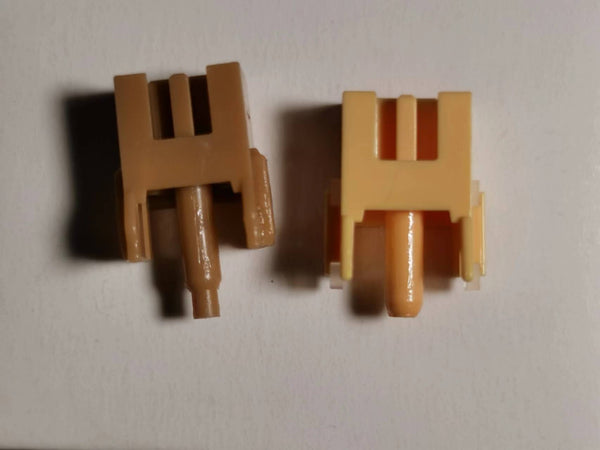Con la introducción de la Teclado de efecto Hall TK75HEHemos despertado la curiosidad de nuestros clientes sobre los interruptores magnéticos Phoenix Silent y de efecto Hall. En una época donde se valora la tranquilidad, especialmente durante las sesiones de escritura nocturnas o las maratones de juegos, la demanda de teclados silenciosos ha aumentado. Profundicemos en los matices de estos interruptores silenciosos y exploremos las diferencias entre las variantes mecánicas y magnéticas.
¿Qué hace que los interruptores silenciosos sean silenciosos?
Comprender la ciencia detrás de los interruptores silenciosos revela su funcionamiento silencioso. Las complejidades estructurales de los interruptores juegan un papel crucial en la amortiguación del sonido. Al comparar el interruptor silencioso Phoenix con los interruptores Venus de Gamakay, se observa una distinción clave: el vástago. La ausencia de un botón saliente en el interruptor Phoenix minimiza el contacto, reduciendo eficazmente los niveles de ruido. Este enfoque integral del clic enfatiza el silencio, garantizando una experiencia de escritura sin interrupciones.


Además, el diámetro y la rigidez de los resortes de los interruptores influyen en la respuesta táctil y la reducción del ruido. Un diámetro de alambre más pequeño y menos espiras resultan en una mayor rigidez del resorte, ofreciendo una sensación más firme al pulsar las teclas. Por el contrario, un diámetro de alambre más grande y más espiras producen resortes más suaves, proporcionando una experiencia de escritura más suave y contribuyendo a un nivel general de silencio.
Estructuras silenciosas mecánicas vs. magnéticas
Si bien ambos tipos ofrecen un funcionamiento silencioso, adoptan enfoques opuestos. Los interruptores mecánicos silenciosos tradicionales, como nuestro Phoenix Interruptores silenciososLos interruptores magnéticos se basan en el contacto físico entre componentes metálicos para registrar las pulsaciones. Por el contrario, los interruptores magnéticos utilizan la fuerza magnética para lograr un funcionamiento prácticamente silencioso. La ausencia de contacto físico reduce la fricción y el ruido, y mejora la durabilidad y la capacidad de respuesta.
Comparación de especificaciones
Analicemos las especificaciones del Phoenix Magnetic Silent Switch y el Phoenix Silent Switch:
| Especificación | Interruptor magnético silencioso Phoenix | Interruptor silencioso Phoenix |
|---|---|---|
| Comportamiento | Lineal | Lineal |
| Distancia de viaje | 4,0 mm | 3,30 mm |
| Pre-recorrido (distancia de actuación) | 2,00 ± 0,5 mm | 2,00 ± 0,6 mm |
| Fuerza de actuación | 45 ± 10 gf | 40 ± 10 gf |
| Fuerza mínima de disparo | 40g | 35 gf |
| Fuerza final | 60 gf | 45 gf |
| Flujo magnético inicial | 150GS | N / A |
| Flujo magnético inferior | 2800GS | N / A |
Ajustabilidad y precisión
A pesar de la mayor fuerza de accionamiento y recorrido del Interruptor Magnético Silencioso Phoenix, los usuarios pueden ajustar con precisión el punto de activación y el recorrido mediante software. La mayor fuerza mínima de accionamiento también reduce la probabilidad de pulsaciones accidentales, lo que garantiza una mayor precisión.
Prueba de sonido del interruptor silencioso Phoenix - Interruptor magnético de efecto Hall
En conclusión, si bien tanto los interruptores Phoenix Silent como los magnéticos ofrecen un funcionamiento silencioso, se adaptan a diferentes preferencias. Los interruptores Phoenix Silent ofrecen una experiencia de escritura táctil con niveles de ruido reducidos, ideal para los entusiastas de los teclados mecánicos tradicionales.Por el contrario, los interruptores magnéticos ofrecen una suavidad y durabilidad incomparables, perfectos para usuarios que buscan la mejor experiencia de escritura silenciosa.
En última instancia, la elección entre interruptores silenciosos mecánicos y magnéticos depende de las preferencias personales y los requisitos de uso. Ya sea que priorice la respuesta táctil, la durabilidad o el silencio absoluto, tenga la seguridad de que... Teclado de efecto Hall TK75HE Con interruptores Phoenix Silent, ofrece una experiencia de escritura de primera calidad que no perturbará la paz.
Compra ahora el teclado con 3 modos de conexión
¿Solo quieres los interruptores silenciosos de tu teclado? Haz clic para comprar el Gamakay. interruptores silenciosos para hacer tu propio teclado silencioso






1 comentario
Hi, I see option to only buy the pheonix mechanical switch. I don’t see the option to buy the pheonix magnetic switch anywhere on the gamakay website. Where can I get replacement switches for my TK75HE ?